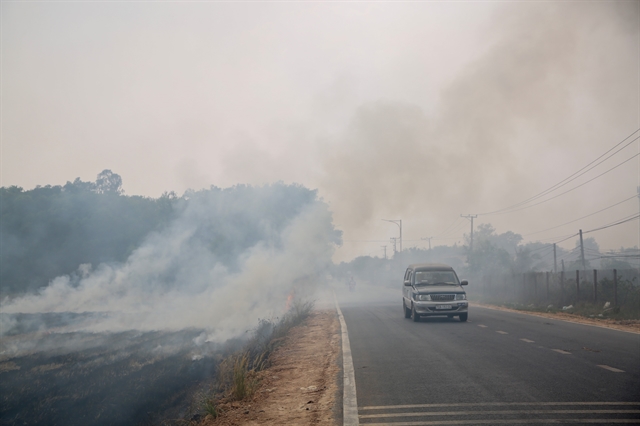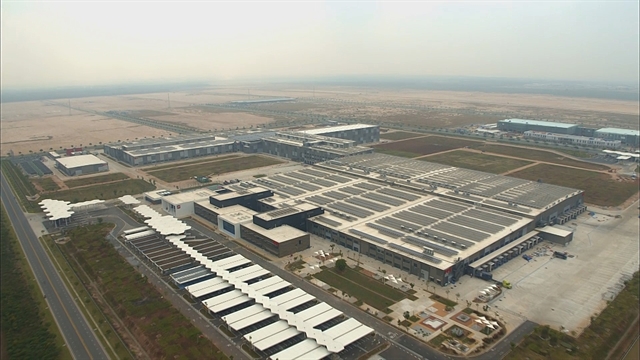 Environment
Environment

 |
| Severe smog in Hà Nội in early February this year. — VNA/VNS Photo Tuấn Anh |
HÀ NỘI — Air pollution is worsening at an alarming rate, prompting a need for changes in awareness, behaviours and collective actions for everyone’s benefit, according to the World Health Organization (WHO).
Speaking about the effects of air quality on human health, Angela Pratt, WHO representative in Việt Nam said that air pollution, both indoor and outdoor, leads to about seven million deaths globally each year.
Meanwhile, Việt Nam reports at least 70,000 deaths due to pollution, meaning every 7.5 seconds, a Vietnamese person dies of a respiratory disease due to being exposed to poor quality air.
According to the WHO, air pollution is caused by particulate matter emitted from industrial zones, transport as well as daily activities such as incineration.
PM2.5 and PM10 are particulate matter measuring 2.5 to 10 micrometres in diameter, which can bypass nasal filters to enter the respiratory system and cause dysfunctions.
These pollutants have been dubbed as the ‘invisible killer’ that cause strokes, heart disease, lung cancer as well as chronic obstructive pulmonary diseases and other respiratory infections.
A report on the state of the environment in Việt Nam, released by the Ministry of Natural Resources and Environment (MONRE) in 2023, also underlined that air pollution, especially PM2.5, is having adverse consequences on human health globally, including Việt Nam.
According to Dr Nguyễn Trọng An, deputy director of the Centre for Health Environment Research and Development (CHERAD), infectious diseases in Việt Nam are rising, with most of them caused by air and water pollution as well as climate change.
Among the ten diseases with the highest mortality rate in Việt Nam, six are respiratory illnesses and can be traced back to air pollution and low air quality.
Another study by the United Nations Development Programme (UNDP) in Việt Nam estimated that economic losses due to air pollution amount to more than US$13 billion per year, equivalent to 4 per cent of the country’s GDP (gross domestic product).
City problems
The capital city of Hà Nội and HCM City, the two major economic hubs of the country, are facing numerous environmental problems due to the rapid urbanisation rate, such as waste, noise pollution and air pollution.
Reports from Hà Nội Department of Natural Resources and Environment showed that air pollution is one of the city’s critical issues.
The annual mean PM2.5 concentration in Hà Nội exceeds the national standard nearly twice over.
The city is also burdened by air pollution from vehicle emissions, charcoal stoves, construction sites, untreated wastewater, farming, industrial facilities within the city and the surrounding areas, as well as the impacts of climate and season changes.
Meanwhile, fine dust monitoring stations across HCM City reported elevated levels of PM2.5 since 2021.
PM2.5 concentration in the city air tends to reach its highest level from the end of the year to March the following year, which coincides with the dry season in the southern region.
WHO Việt Nam representative Angela Pratt said that the figure of 70,000 deaths per year due to air pollution in Việt Nam is almost double the country’s COVID-19 death toll.
Therefore, Việt Nam needs to address air pollution the same way it handled COVID-19, by seeing this phenomenon as a public health emergency, she said.
She pointed out that the most effective response to a public health emergency requires actions at different levels.
Specifically and most pressing, Việt Nam needs measures to limit exposure to pollutants and protect high-risk groups. In the medium and long term, it is necessary to address the root causes, which in this case are pollution sources including fossil fuels, vehicle emissions and straw burning after harvests.
Meanwhile, UNDP has taken various measures to improve Việt Nam’s air quality, notably the efforts for Just Energy Transition Partnership (JETP) and Việt Nam’s commitment to net-zero by 2050, among other activities for green transportation, forming a circular economy and waste management.
 |
| Straw burning after harvests, a local agricultural practice, is identified as a key factor in rising air pollution. — VNA/VNS Photo Giang Phương |
Việt Nam has also issued a National Plan on Air Quality Management, aiming to strengthen air quality management through controlling emission sources as well as air quality forecasting and monitoring.
In March this year, Hà Nội People’s Committee approved its air quality management plan by 2030 with a vision to 2035, which the city’s deputy director of the environmental protection department Lưu Thị Thanh Chi considered a pivotal document that takes into account collaboration between state agencies, the community and international partners.
The plan states that by 2030, Hà Nội will ensure its air quality remains between the good and average level, according to the air quality index (AQI) at least 75 per cent of the year.
The city also aims to reduce PM2.5 emissions by 20 per cent, equivalent to about 6,200 tonnes of PM2.5.
Hà Nội has eliminated more than 99 per cent of charcoal stoves in the country and reduced straw burning incidence in the suburbs by 80 per cent, alongside a pilot programme to measure emissions from old vehicles in operation.
Meanwhile, the 2024-2025 plan to strengthen air pollution control in HCM City sets out the goal to decrease transport-induced pollution by 85 per cent next year.
The document also aims to ensure that at least 97 per cent of industrial facilities releasing emissions meet environmental technical regulations.
All industrial plants with significant emissions must have automatic air monitoring systems installed, from which live data will be sent to the city’s Department of Natural Resources and Environment.
Other areas of focus for emission control include construction sites, agricultural practices and household waste management.
Dr Hoàng Anh Lê from the University of Science (under Việt Nam National University - Hà Nội) said that there is a lack of awareness of air pollution effects on health among Vietnamese people, as these impacts slowly emerge over time rather than immediately.
Therefore, raising public awareness must be a priority for effective measures against air pollution, he said. — VNS




